Rock'n Bowl
Space Habitats of Nuclear Acquisition and Construction
by J.R. Mooneyham
This item orginally published in Spring 1993
_______________________________
_______(Free JavaScripts provided by The JavaScript Source)_______
|
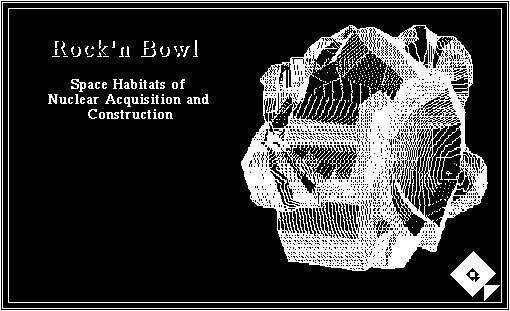
Rock'n Bowl is a minor brainstorm of mine from a couple of years ago. I sent it to a few folks that I thought might find it of interest, like Jerry Pournelle ( of BYTE and sci fi fame ), and his sometime collaborator Larry Niven ( Ringworld author ) ( At least, Pournelle said he showed it to Niven. Mr. Niven never brought it up in subsequent correspondence I had with him later, concerning another subject ). I also sent it to Carl Sagan ( PBS Cosmos ), and NASA, among others. Just in case it might have anything worthwhile in it.
Hey- I'm a sci fi fan, and a great proponent for space development. What else could I do?
Anyway, even if it proved practical to implement, it'd still rank as a hugely ambitious project; so we're not likely to see anything like it actually undertaken for another fifty years or so. Tsk, tsk.
I've included it here in FLUX in case some of you out there might find it interesting as well ( Like so much of my stuff, I pretty much did the thing 'off the top of my head' at the time, so feel free to point out any mistakes or improvements you happen to come up with concerning the material. )
I also should mention that Mark ( our resident scientific B.S. filter ) got no chance at all to examine this material before publication. So it's not his fault if there's any major screw ups in the physics or space sciences involved.
Thanks!•
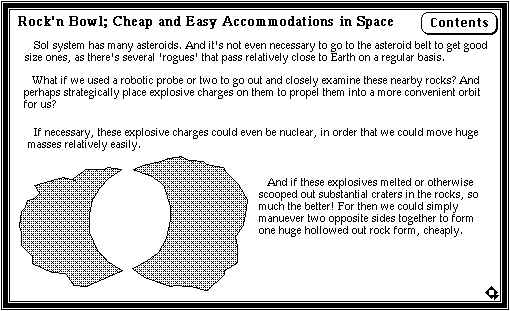
The two different rocks could be fused together by the use of smaller charges about the meeting edges (In Earthside construction circa 1978 I personally observed ‘flash-welding’ of large underground electrical connections with small charges, in a similar process. Why couldn’t we do something like this in space?) If extra material was needed like that of a welding rod in the process we could simply chip it off the outer surfaces of the asteroid as needed, and add to the meeting edges prior to the fusing explosions.
(Of course, there would be other alternatives to using explosive charges for this welding process, if it proved undesireable)
Careful calculations and timing would have to be used so that these small charges didn’t move things around in unwanted ways. For instance, each welding explosion might require a twin on the opposite side to occur simultaneously to prevent a net movement of the rocks.
Notice that the use of carefully calculated and placed explosives for rock movement, shaping, and fusion, would minimize the amount of mass required to lift from Earth to accomplish these tasks, and perhaps greatly simplify the procedures too, in terms of jobs requiring men onsite.
So now let’s assume we have one gigantic, leaky, hollow chunk of rock orbiting in a reasonable location. How do we make it useful?
Well, let’s say we want its interior dimensions more aethestically pleasing, and easier to design for.
We could better shape the interior with more but smaller charges, chipping away and sculpting the rock as desired. Let’s assume we go for a roughly spherical shape, since we can get the most internal volume for the least surface area that way, and so get maximum efficiency concerning things like conservation of internal heat.
We don’t need this spherical shape to be perfect by any means; for we have far better methods to apply the finishing touches.
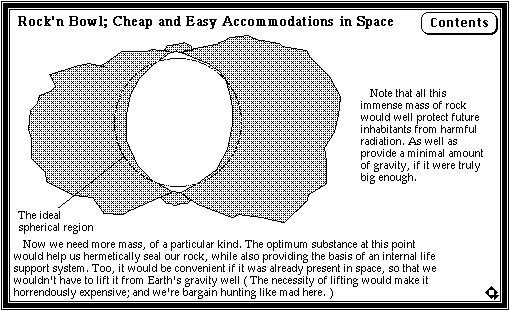
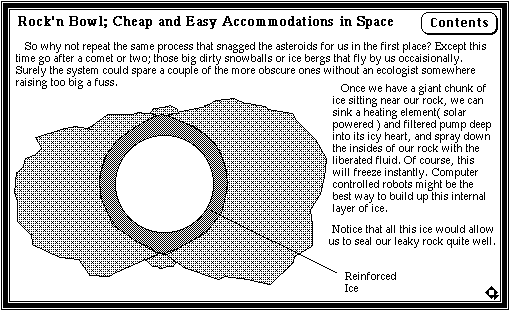
Of course, hopefully we remembered to insert the appropriate air locks and docking stations into the meeting edge band, before we fused the two rocks together, and then began sealing everything with the ice. We might want to use more refined materials for the air locks. For instance, spent fuel tanks from old rockets might be well adapted to this purpose, if we can find any floating around in orbit. This could provide us with very spacious airlock capabilities.
So let’s say we create a layer of ice several feet thick inside the rock. This supplements the rock’s capacity to block harmful radiation, seals leaks between the meeting edges of the construction, adds more mass to create a bit of gravity effect, and even provides extra protection for inhabitants if the rock ever began skimming the atmosphere as result of orbital decay; the ice would buffer the heat of friction with the air, and make the rock last a lot longer than it otherwise would, providing more orbits during which to evacuate the thing.
So after we’ve laid down a few feet of ice, we begin adding a bit to the structural integrity of the ice layer. By laying down a network of tough nylon mesh or some other such material, and freezing more ice over it. This webbing could be very fine and strong, and yet lightweight as well, so not a great burden to boost to orbit per square meter.
So, inside a layer of pure ice several feet thick, we add more layers of ice, reinforced with nylon netting.
Then we apply heat reflecting foil atop all this (from the interior perspective), to cut heat losses.
Next we begin spraying something different. Chemicals that bulk up to create a foamy insulating layer. The first layers applied will be in vacuum. Hopefully we can come up with a mixture that bulks up with a ratio of 20:1 or better, so we get maximum effectiveness for the raw materials we boost to orbit.
We won’t have any air to act as a catalyst for the chemical reaction to help the foaming effect if needed, but perhaps the comet water might help here.
As the pressurization of the rock interior became necessary, we might luck out and get a comet with some frozen nitrogen and/or oxygen mixed into it as well? But even if it was only water and nothing more, we could still ‘crack’ the water to produce some oxygen, and at least minimize the amount of that particular element that we’d have to boost to orbit.
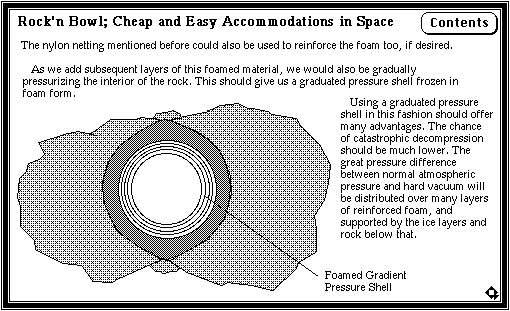
The reflective foil layers and foam should help to insulate the interior from the cold of space.
Once all this foundation has been laid, we are ready to construct the interior habitation and life support infrastructure.
The next layer should be liquid water. Garnered from the melted and filtered comet mass. This water will serve as the basis of the interior ecosystem, since the rock will ultimately have to be self-sufficient.
Also, if a leak to vacuum somehow did occur, this shell of water encompassing the inner living areas would likely plug it by rushing to it and freezing to plug the hole. So the Rock would be ‘self-healing’ to a great extent.
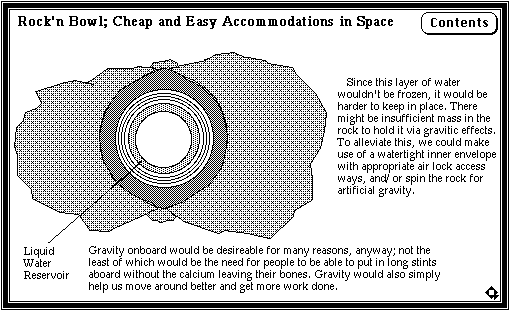
More asteroids could also be herded in and attached to the rock, to increase mass derived gravity. But this would be a bulky and cumbersome solution.
Such ‘Rock’n Bowl’ habitats would be well suited to serve as massive orbital stations, or as long term exploration and colonization mission craft, such as for a Mars expedition.
A single ‘backbone’ truss structure could be assembled running through the center of the interior, along the axis of rotation (of any), and used as a skeleton to hang other internal framework off of, as desired.
Somewhere along here we’ll begin wanting to use more refined materials in the construction of this abode. But boosting it all from groundside would be enormously expensive. So why not just use what’s already up there?
There’s all kinds of high tech garbage floating around in orbit now. It’s even starting to get in the way of space flights! So why not collect this stuff and recycle it into the Rock?
Robotic platforms (maybe the same ones that planted the bombs on the original asteroids) could go around collecting stuff literally with a big net. This would save a ton of money in many ways, not the least of which would be that we wouldn’t need men flopping around doing the collecting.
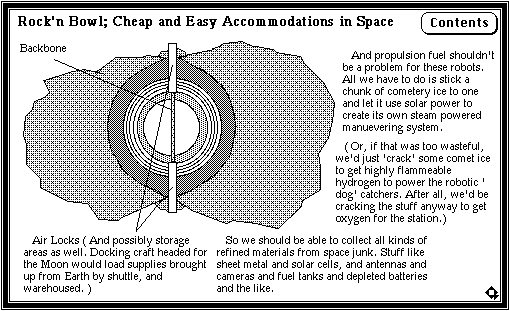
This automated salvage process and use of comet ice for propulsion, and other factors, should allow us to concentrate on boosting to orbit primarily just essentials that would enable us to minimize even further the amount of mass lifted. Like little furnaces that we could use to melt down and reform old satellite materials and asteroid rock as necessary. With careful planning and some imagination we could have an enormous and self sufficient space station on the cheap. And fairly quickly too.
But still it’d be nice if we could cut the expenses of transferring stuff to orbit and back somehow. Because no matter how much we minimize what has to be boosted, still every penny will count.
So what about those missiles that fighter jets can supposedly shoot at satellites from the upper levels of the atmosphere? Would we save money by using these things to carry supplies to the rock? If the missile could just make it out of the atmosphere far enough and long enough for our little robotic ‘dog catchers’ to come along and scoop them up with their satellite catch nets, we could get some supplies that way.
The jets could do this on a regular basis as part of their routine flights; it wouldn’t have to be a special deal. After all, part of the national defense strategy is to always have some jets in the air. Why not have them do something constructive while they’re up there?
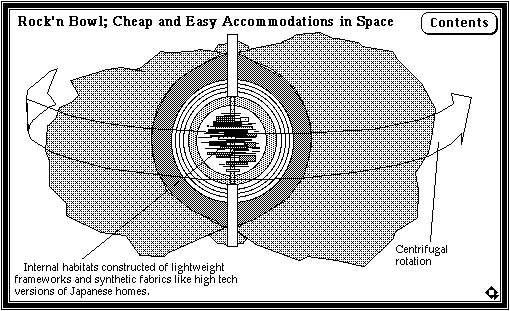
Bigger missiles could be hoisted aloft by B-52s like the experimental rocket planes of the fifties and sixties were. And carry bigger payloads (maybe even people). As long as they got high enough for our dog catchers to get them, we’d be in good shape.
Note that the cost-effectiveness of this ‘Rock’n Bowl’ concept would likely be directly proportional to its overall size; at least over a wide range. In other words, the bigger it was, the cheaper the rate per cubic feet of volume. This would suggest that the maximum size of such projects would be limited mainly by the upper limits on what the Earth/Moon system could withstand in terms of extra mass, and the quantity of raw material in asteroid and comet form that we could easily acquire.
I mentioned before the single strong ‘backbone’ structure running through the central axis of the Rock. This backbone could serve both as the main thoroughfare of the station and as the foundation for all the internal habitats to be hung upon. Note that since the rock, ice, foam, and water protect against the vacuum and cold of space, and the backbone and rock provide inner and outer rigidity, and rotation will exert a centrifugal force, the internal habitats can be of quite flimsy construction by comparison. So flimsy, in fact, that these habitats might consist largely of something akin to PVC or aluminum piping for compressive structural factors, nylon fabrics for walls, and strong synthetic cords and netting for tensile elements. Picture a high tech version of a paper walled Japanese house and you see something of the internal habitat of the Rock.
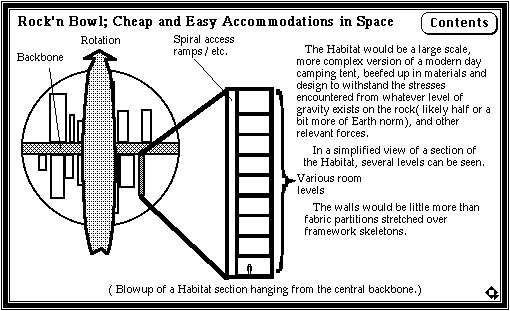
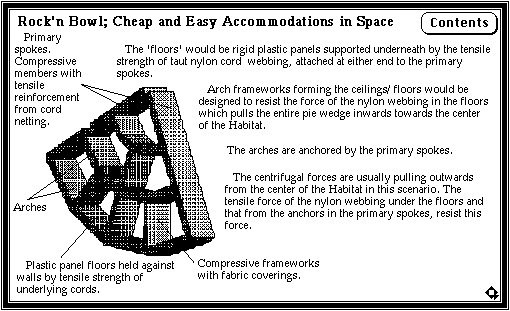
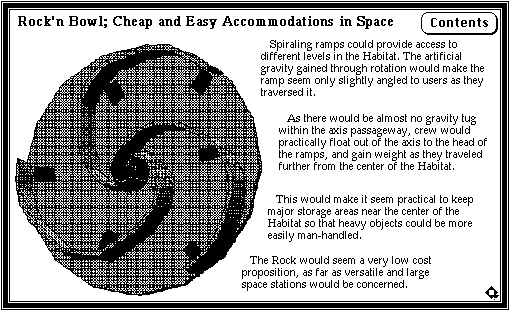
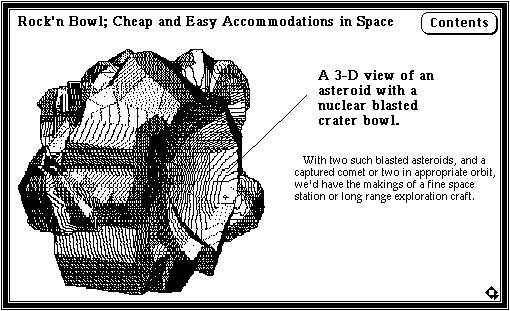
The above article(s) come from and make references to a collection copyright © 1993,
1994, 1995, 1996, 1997, 1998, 1999, 2000, 2001, 2002 by J.R. Mooneyham (except where otherwise noted in the text). Text here explicitly authored by J.R. Mooneyham may be freely copied and
distributed for non-commercial purposes in paper and electronic form without charge if this copyright
paragraph and link to jrmooneyham.com are included.
Back to the Table of Contents of the Signposts Timeline
Back to J.R.'s
WebFLUX Page (the magazine)
Back to J.R.'s
WebWork Page (A hefty catalog of links to almost everything)
Site Map for the
WebFLUX and WebWork pages


















